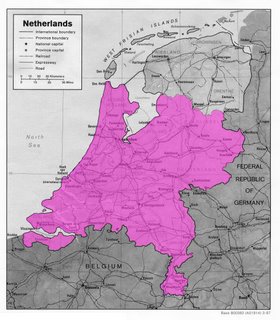
The Netherlands is the European Unions chief exporter of pork producing 16.5 million tons each year. This results in a conflict between urbanization and agriculture. Experts calculated that to raise pigs organically, each one would require approximately 18,600 square feet of land (shown above), leaving a miniscule 25% of the country habitable for humans. As a hypothetical solution to this “problem” the architecture firm MVRDV has suggested “Pig City.” It is comprised of 76 towers rising 500 meters into the sky. Pig City addresses issues such as organic farming, and meat production. It solves transportation and distribution problems- as the city is entirely self-contained, this would potentially reduce the spread of disease.
As described by MVRDV;
There would be no more jostling in trucks en route to slaughter - slaughterhouses would be located at the bottom of each tower, requiring each pig to take a short ride in an elevator.
 Pigs would be organically fed on grain grown around the towers and tiaplia fish, a high-protein food source which, in the ultimate recycling dream, would be fed on pig waste. Each animal would get ample space, trees in their pens and terraces with truffles planted beneath the roots to allow the animals to snuffle around.
Pigs would be organically fed on grain grown around the towers and tiaplia fish, a high-protein food source which, in the ultimate recycling dream, would be fed on pig waste. Each animal would get ample space, trees in their pens and terraces with truffles planted beneath the roots to allow the animals to snuffle around.Waste not fed to fish may be reprocessed into methane, which would power the towers and provide
 electricity to thousands of homes.
electricity to thousands of homes.A certain power plant in North Devon, UK, can produce around 2100 kw hours of power. This supplies close to 300 homes and public buildings with a heating scheme that can be used to heat their water.
With current methane collecting
 technology: 4,400 pigs put out 80 kW hours per day. One tower in Pig City consists of100 stories with 100 pigs per story and the city is comprised of 76 towers. 760,000 pigs result in approximately 14,000 kilowatt hours per day. In the Netherlands an average family of 4 uses 44 kilowatt hours a day, at this rate Pig City could supply about 318 homes with power, which is comparable to the power plant in North Devon, Uk. Even though the proposal for a city full of pigs seems absurd, it is possible as an alternate form of energy production.
technology: 4,400 pigs put out 80 kW hours per day. One tower in Pig City consists of100 stories with 100 pigs per story and the city is comprised of 76 towers. 760,000 pigs result in approximately 14,000 kilowatt hours per day. In the Netherlands an average family of 4 uses 44 kilowatt hours a day, at this rate Pig City could supply about 318 homes with power, which is comparable to the power plant in North Devon, Uk. Even though the proposal for a city full of pigs seems absurd, it is possible as an alternate form of energy production.